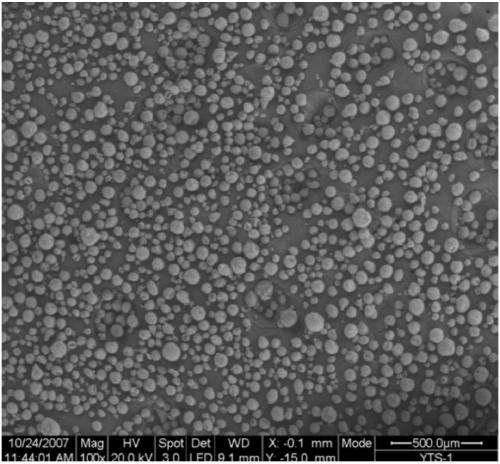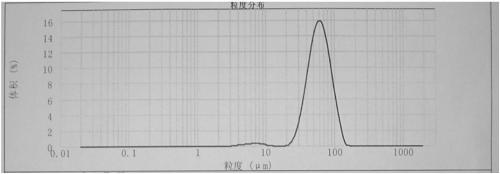Microsphere Silicate-1 molecular sieve catalyst and preparation method thereof, and caprolactam preparation method
A molecular sieve and catalyst technology, applied in the field of preparing caprolactam, can solve the problems of high gas-solid separation requirements, difficult pumping, low thermal efficiency of spray forming, etc.
- Summary
- Abstract
- Description
- Claims
- Application Information
AI Technical Summary
Problems solved by technology
Method used
Image
Examples
Embodiment 1
[0092] (1) Tetrapropyl ammonium hydroxide (abbreviated as TPAOH) of 41.6g tetraethyl orthosilicate, 36g 22.5% by weight (abbreviated as TPAOH), 23g ethanol (abbreviated as EtOH), 0.0056gFe(NO 3 ) 3 9H 2 O and 41.5g of water were mixed, and stirred at room temperature for 5 hours to form a colloidal mixture with a pH value of 12.8, and SiO in the mixture 2 :EtOH:TPAOH:H 2 O (molar ratio) = 1:6.5:0.2:20, SiO 2 with Fe 3+ The weight ratio was 15347:1. The above mixture was transferred into a 300ml stainless steel reactor and crystallized at 100°C for 3 days to obtain 140g of molecular sieve slurry with a solid content of 8.5% by weight and a pH of 13.60. Take a small amount of the molecular sieve slurry and dry it at 120°C for 20 hours to obtain Silicate-1 molecular sieve raw powder containing trace metal ions. The measured iron ion content is 64ppm, and the BET specific surface area is 446m 2 / g, the outer specific surface is 61 meters 2 / g, the particle size is 0.1-0.2μm....
Embodiment 2
[0098] (1) Tetrapropyl ammonium hydroxide (abbreviated as TPAOH) of 41.6g tetraethyl orthosilicate, 36g 22.5% by weight (abbreviated as TPAOH), 23g ethanol (abbreviated as EtOH), 0.0236gAl (NO 3 ) 3 9H 2 O and 41g of water were mixed and stirred at room temperature for 5 hours to form a colloidal mixture with a pH value of 12.4, and SiO in the mixture 2 :EtOH:TPAOH:H 2 O (molar ratio) = 1:6.5:0.2:20, SiO 2 with Al 3+ The weight ratio was 7067:1. The above mixture was transferred into a 300ml stainless steel reactor and crystallized at 100°C for 3 days to obtain 140g of molecular sieve slurry with a solid content of 8.57% by weight and a pH of 13.76. Take a small amount of the molecular sieve slurry and dry it at 120°C for 20 hours to obtain Silicate-1 molecular sieve raw powder containing trace metal ions. The measured aluminum ion content is 140ppm, and the BET specific surface area is 433m 2 / g, the outer specific surface is 51 meters 2 / g, the particle size is 0.1-0.2...
Embodiment 3
[0104] (1) 41.6g tetrapropyl ammonium hydroxide (abbreviated as TPAOH), 0.0008g ZrOCl 2 ·8H 2 O and 42g of water were mixed and stirred at room temperature for 5 hours to form a colloidal mixture with a pH value of 12.46, and SiO in the mixture 2 :TPAOH:H 2 O (molar ratio) = 1:0.2:20, SiO 2 with Zr 4+ The weight ratio was 50596:1. The above mixture was transferred into a 300ml stainless steel reactor, and crystallized at 100°C for 3 days to obtain 140g of molecular sieve slurry with a solid content of 8.57% by weight and a pH value of 13.42. Take a small amount of the molecular sieve slurry and send it to dry at 120°C for 20 hours to obtain Silicate-1 molecular sieve raw powder containing trace metal ions. The measured zirconium ion content is 20ppm, and the BET specific surface area is 428 meters 2 / g, the outer specific surface is 48 meters 2 / g, the particle size is 0.1-0.25μm.
[0105] (2) Mix and stir 13.1g tetraethyl orthosilicate and 22g deionized water, adjust th...
PUM
| Property | Measurement | Unit |
|---|---|---|
| particle diameter | aaaaa | aaaaa |
| specific surface area | aaaaa | aaaaa |
| particle diameter | aaaaa | aaaaa |
Abstract
Description
Claims
Application Information
 Login to View More
Login to View More - R&D
- Intellectual Property
- Life Sciences
- Materials
- Tech Scout
- Unparalleled Data Quality
- Higher Quality Content
- 60% Fewer Hallucinations
Browse by: Latest US Patents, China's latest patents, Technical Efficacy Thesaurus, Application Domain, Technology Topic, Popular Technical Reports.
© 2025 PatSnap. All rights reserved.Legal|Privacy policy|Modern Slavery Act Transparency Statement|Sitemap|About US| Contact US: help@patsnap.com



